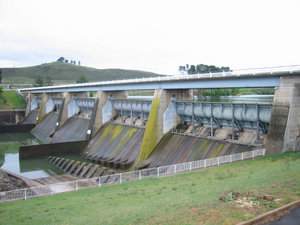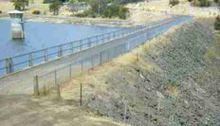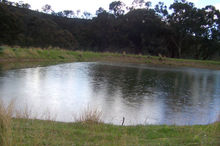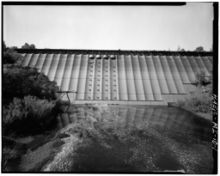Dam
2007 Schools Wikipedia Selection. Related subjects: Engineering
A dam is a barrier across flowing water that obstructs, directs or retards the flow, often creating a reservoir, lake or impoundment. In Australian and South African English, the word "dam" can also refer to the reservoir rather than the structure. Most dams have a section called a spillway or weir over which or through which it is intended that water will flow either intermittently or continuously.
History
Some of the first dams were built in Mesopotamia up to 7,000 years ago. These were used to control the water level, for Mesopotamia's weather effected the Tigris and Euphrates rivers and could be quite unpredictable.The earliest recorded dam is believed to have been on the nile river at Kosheish, where a 15m high masonary structure was built about 2900 B.C. to supply water to capital of Memphis.
Types of dams
Dams can be formed by human agency, natural causes, or by the intervention of wildlife such as beavers. Man-made dams are typically classified according to thier structure, intended purpose or height.
Based on structure and material used, dams are classified as timber dams, embankment dams or masonry dams, with several subtypes.
Intended purposes include providing water for irrigation or town or city water supply, improving navigation, creating a reservoir of water to supply industrial uses, generating hydroelectric power, creating recreation areas or habitat for fish and wildlife, flood control and containing effluent from industrial sites such as mines or factories. Few dams serve all of these purposes but some multi-purpose dams serve more than one.
According to height, a large dam is higher than 15 metres and a major dam is over 150 metres in height. Alternatively, a low dam is less than 30 m high; a medium-height dam is between 30 and 100 m high, and a high dam is over 100 m high.
A saddle dam is an auxiliary dam constructed to confine the reservoir created by a primary dam either to permit a higher water elevation and storage or to limit the extent of a reservoir for increased efficiency. An auxiliary dam is constructed in a low spot or saddle through which the reservoir would otherwise escape. On occasion, a reservoir is contained by a similar structure called a dike to prevent inundation of nearby land. Dikes are commonly used for reclamation of arable land from a shallow lake. This is similar to a levee, which is a wall or embankment built along a river or stream to protect adjacent land from flooding.
An overflow dam is designed to be overtopped. A weir is a type of small overflow dam that can be used for flow measurement.
A check dam is a small dam designed to reduce flow velocity and control soil erosion. Conversely, a wing dam is a structure that only partly restricts a waterway, creating a faster channel that resists the accumulation of sediment.
A dry dam is a dam designed to control flooding. It normally holds back no water and allows the channel to flow freely, except during periods of intense flow that would otherwise cause flooding downstream.
Diversionary dams
A diversionary dam is a structure designed to divert all or a portion of the flow of a river from its natural course.
Timber dams
Timber dams were widely used in the early part of the industrial revolution and in frontier areas due to ease and speed of construction. Rarely built in modern times by humans due to relatively short lifespan and limited height to which they can be built, timber dams must be kept constantly wet in order to maintain their water retention properties and limit deterioration by rot, similar to a barrel. The locations where timber dams are most economical to build are those where timber is plentiful, cement is costly or difficult to transport, and either a low head diversion dam is required or longevity is not an issue. Timber dams were once numerous, especially in the North American west, but most have failed, been hidden under earth embankments or been replaced with entirely new structures. Two common variations of timber dams were the crib and the plank.
Timber crib dams were erected of heavy timbers or dressed logs in the manner of a log house and the interior filled with earth or rubble. The heavy crib structure supported the dam's face and the weight of the water.
Timber plank dams were more elegant structures that employed a variety of construction methods utilizing heavy timbers to support a water retaining arrangement of planks.
Very few timber dams are still in use. Timber, in the form of sticks, branches and withes, is the basic material used by beavers, often with the addition of mud or stones.
Embankment dams
Embankment dams are made from compacted earth, and have two main types, rock-fill and earth-fill dams. Embankment dams rely on their weight to hold back the force of water, like the gravity dams made from concrete.
Rock-fill dams
Rock-fill dams are embankments of compacted free-draining granular earth with an impervious zone. The earth utilized often contains a large percentage of large particles hence the term rock-fill. The impervious zone may be on the upstream face and made of masonry, concrete, plastic membrane, steel sheet piles, timber or other material. The impervious zone may also be within the embankment in which case it is referred to as a core. In the instances where clay is utilized as the impervious material the dam is referred to as a composite dam. When suitable material is at hand, transportation is minimized leading to cost savings during construction. Rock-fill dams are highly resistant to damage from earthquakes. However, inadequate quality control during construction can lead to excessive fines in the embankment which can lead to liquefaction of the rock-fill during an earthquake. This problem can be eliminated by keeping susceptible material dry. New Melones Dam is a rock-fill dam.
Earth dams
Earth dams, also called earthen, rolled-earth and earth-fill dams, are constructed of well compacted earth. A homogeneous rolled-earth dam is entirely constructed of one type of material but may contain a drain layer to collect seep water. A zoned-earth dam has distinct parts or zones of dissimilar material, typically a locally plentiful shell with a watertight clay core. Modern zoned-earth embankments employ filter and drain zones to collect and remove seep water and preserve the integrity of the downstream shell zone. An outdated method of zoned earth dam construction utilized a hydraulic fill to produce a watertight core. Rolled-earth dams may also employ a watertight facing or core in the manner of a rock-fill dam. An interesting type of temporary earth dam occasionally used in high latitudes is the frozen-core dam, in which a coolant is circulated through pipes inside the dam to maintain a watertight region of permafrost within it. Oroville Dam is an example of an earth dam, and is the tallest dam in the United States.
Masonry dams
Masonry dams are of either the gravity or the arch type.
Gravity dams
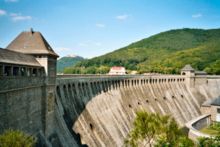
In a gravity dam, stability is secured by making it of such a size and shape that it will resist overturning, sliding and crushing at the toe. The dam will not overturn provided that the moment around the turning point, caused by the water pressure is smaller than the moment caused by the weight of the dam. This is the case if the resultant force of water pressure and weight falls within the base of the dam. However, in order to prevent tensile stress at the upstream face and excessive compressive stress at the downstream face, the dam cross section is usually designed so that the resultant falls within the middle at all elevations of the cross section (the core). For this type of dam, impervious foundations with high bearing strength are essential.
When situated on a suitable site, a gravity dam inspires more confidence in the layman than any other type; it has mass that lends an atmosphere of permanence, stability, and safety. When built on a carefully studied foundation with stresses calculated from completely evaluated loads, the gravity dam probably represents the best developed example of the art of dam building. This is significant because the fear of flood is a strong motivator in many regions, and has resulted in gravity dams being built in some instances where an arch dam would have been more economical.
Gravity dams are classified as "solid" or "hollow." The solid form is the more widely used of the two, though the hollow dam is frequently more economical to construct. Gravity dams can also be classified as "overflow" (spillway) and "non-overflow." Grand Coulee Dam is a solid gravity dam and Itaipu Dam is a hollow gravity dam.
With a height of 285m the tallest gravity dam in the world is the Grande Dixence Dam in Switzerland.
Arch dams
In the arch dam, stability is obtained by a combination of arch and gravity action. If the upstream face is vertical the entire weight of the dam must be carried to the foundation by gravity, while the distribution of the normal hydrostatic pressure between vertical cantilever and arch action will depend upon the stiffness of the dam in a vertical and horizontal direction. When the upstream face is sloped the distribution is more complicated. The normal component of the weight of the arch ring may be taken by the arch action, while the normal hydrostatic pressure will be distributed as described above. For this type of dam, firm reliable supports at the abutments (either buttress or canyon side wall) are more important. The most desirable place for an arch dam is a narrow canyon with steep side walls composed of sound rock. The safety of an arch dam is dependent on the strength of the side wall abutments, hence not only should the arch be well seated on the side walls but also the character of the rock should be carefully inspected.
Two types of single-arch dams are in use, namely the constant-angle and the constant-radius dam. The constant-radius type employs the same face radius at all elevations of the dam, which means that as the channel grows narrower towards the bottom of the dam the central angle subtended by the face of the dam becomes smaller. Jones Falls Dam, in Canada, is a constant radius dam. In a constant-angle dam, also known as a variable radius dam, this subtended angle is kept a constant and the variation in distance between the abutments at various levels are taken care of by varying the radii. Constant-radius dams are much less common than constant-angle dams. Parker Dam is a constant-angle arch dam.
A similar type is the double-curvature or thin-shell dam. Wildhorse Dam near Mountain City, Nevada in the United States is an example of the type. This method of construction minimizes the amount of concrete necessary for construction but transmits large loads to the foundation and abutments. The appearance is similar to a single-arch dam but with a distinct vertical curvature to it as well lending it the vague appearance of a concave lens as viewed from downstream.
The multiple-arch dam consists of a number of single-arch dams with concrete buttresses as the supporting abutments. The multiple-arch dam does not require as many buttresses as the hollow gravity type, but requires good rock foundation because the buttress loads are heavy. See Geotechnical engineering.
Steel dams
A steel dam is a type of dam briefly experimented with in around the turn of the 19th-20th century which uses steel plating (at an angle) and load bearing beams as the structure. Intended as permanent structures, steel dams were an (arguably failed) experiment to determine if a construction technique could be devised that was cheaper than masonry, concrete or earthworks, but sturdier than timber crib dams. Only two examples remain in the US.
Cofferdams
A cofferdam is a (usually temporary) barrier constructed to exclude water from an area that is normally submerged. Made commonly of wood, concrete or steel sheet piling, cofferdams are used to allow construction on the foundation of permanent dams, bridges, and similar structures. When the project is completed, the cofferdam may be demolished or removed. See also causeway and retaining wall.
Beaver dams
Spillways
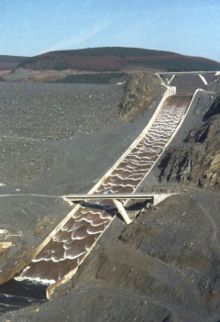
A spillway is a section of a dam designed to pass water from the upstream side of a dam to the downstream side. Many spillways have floodgates designed to control the flow through the spillway.
A service spillway or primary spillway passes normal flow. An auxiliary spillway releases flow in excess of the capacity of the service spillway. An emergency spillway is designed for extreme conditions, such as a serious malfunction of the service spillway. A fuse-plug spillway is a low embankment designed to be overtopped and washed away in the event of a large flood.
Any cavitation or turbulence of the water flowing over the spillway slowly erodes the dam's wetted surfaces. To minimize that erosion (especially with maximum water elevation at the crest), the downstream face of the spillway is ordinarily made an ogee curve.
It was the inadequate design of the spillway that caused the overtopping of a dam that caused the infamous Johnstown Flood.
Other considerations
The best place for building a dam is a narrow part of a deep river valley; the valley sides can then act as natural walls. The primary function of the dam's structure is to fill the gap in the natural reservoir line left by the stream channel. The sites are usually those where the gap becomes a minimum for the required storage capacity. The most economical arrangement is often a composite structure such as a masonry dam flanked by earth embankments. The current use of the land to be flooded should be dispensable.
Significant other engineering and engineering geology considerations when building a dam include:
- permeability of the surrounding rock or soil
- earthquake faults
- landslides and slope stability
- peak flood flows
- reservoir silting
- environmental impacts on river fisheries, forests and wildlife (see fish ladder)
- impacts on human habitations
- compensation for land being flooded as well as population resettlement
- removal of toxic materials and buildings from the proposed reservoir area
Dam failures are generally catastrophic if the structure is breached or significantly damaged. Routine monitoring of seepage from drains in, and around, larger dams is necessary to anticipate any problems and permit remedial action to be taken before structural failure occurs. Most dams incorporate mechanisms to permit the reservoir to be lowered or even drained in the event of such problems. Another solution can be rock grouting - pressure pumping portland cement slurry into weak fractured rock.
Environmental impacts
( Source: Canadian Geographic)
More than half of the world’s large rivers have been dammed, regulating and flooding approximately 400,000 square kilometres of land worldwide. These diversions have an effect on diverse ecosystems and habitats around the globe, replacing them with uniform structures and reservoirs and ultimately changing the way otherwise balanced, stable ecosystems function.
Stream flow
The life of a river is closely tied to its stream flow, which constantly fluctuates. Damming a river and altering its flow pattern generates a number of physical and biological impacts. The disruption of a river’s flow obstructs its natural current and affects the water’s habitat.
One of the largest impacts a lack of current has on a river is the sediment flow, which is normally carried down the river by the current. When trapped by a dam, the sediment is held in the reservoir and settles to the bottom while clear water containing very little sediment is released down the river.
Over time, the easily erodible material from the riverbed is carried away with no sediment being deposited to replace it. This leaves a rocky stream bed, resulting in a poorer habitat for aquatic fauna.
Barrier to migration
The most visible and obvious effect of dams is that they fragment rivers and make migration difficult for fish and other aquatic life. Species such as salmon and eels, which migrate to spawn, may not make it to their destination or may suffer injury or death while traveling through turbines or over spillways. Fish that do make it through are often disoriented and become more susceptible to predators.
Some dams are equipped with fish passage structures, or fish ladders, to attempt to accommodate the migration of a river’s aquatic life. Questions have been raised as to whether fish ladders are actually too stressful for adult fish and reduce their chances for successful spawning.
Water quality impacts
When water is held in the reservoir of a dam, the quality of water is affected in several ways, the extent of which depending on how long it is held there.
The initial creation of a reservoir on a floodplain submerges the existing vegetation and soil, causing much of the organic material to decompose over time which can deplete oxygen from the water supply.
The establishment of a deep reservoir will almost always lead to thermal stratification during summer months. Water warmed by the sun forms an upper warm layer called the Epilimnion which is well oxygenated. The bulk of the water is held in the lower, cold unmixed layer, the Hypolimnion. This cold water receives relatively little light, has no contact with the air and is often depleted in oxygen. The boundary between these two layers is the thermocline.
Where draw-off towers or sluices in dams release water from the Hypolimnion into the downstream river, the water discharged may be unusually cold and may be low in oxygen and high in metals such as Manganese. All these properties can have seriously adverse effects on the normal biota of a river.
Mercury, which can exist at very low levels in the soil, may be transformed by bacteria into methyl mercury once the soil is flooded if the benthic conditions become substantially anoxic. Methyl mercury is a cumulative toxin to veterbrate species and may enter the food chain from consumption of reservoir fish. Such circumstances are theoretically possible but very rare in practice.
Examples of failed dams
- Baldwin Hills Reservoir - 1963
- Banqiao and Shimantan Dams - 1975
- Big Bay Dam, Mississippi - 2004
- Buffalo Creek Flood - 1972
- Camará Dam - 2004
- South Fork Dam - 1889
- Kelly Barnes Dam - 1977
- Lawn Lake Dam - 1982
- Malpasset, Côte d'Azur, France - 1959
- Opuha Dam - 1997
- Shakidor Dam - 2005
- St. Francis Dam, Los Angeles, California - 1928
- Taum Sauk reservoir - 2005
- Teton Dam - 1976
- Tous Dam, Valencia, Spain - 1982
- Vajont Dam - 1961
- Val di Stava Dam Collapse - 1985
